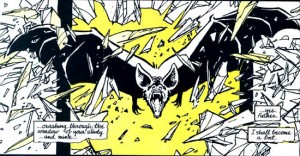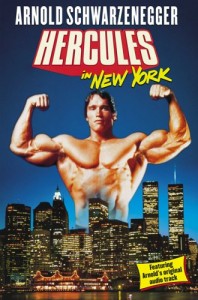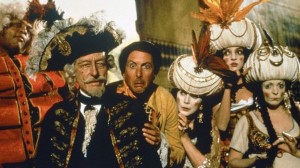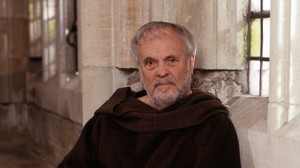Each Thursday, I’ll be stringing together some of the disconnected thoughts I’ve had about the subject of my dissertation, in a feature I call “Thesis Thursday“. You’ll have to pardon the length, as dissertations don’t easily fit the bloggy mold. To begin things properly (and meta-tastically), the subject for this week is beginnings and origin stories.
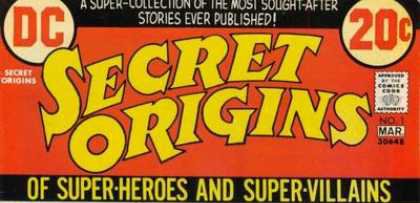
As you might have independently surmised from my recent Thor review, I can’t stand most Hollywood movies based on comics. It’s not that I hate Hollywood, movies, or adaptations per se, just that I can’t stand movies built around origin stories, and the first Hollywood movie about a comic book hero ((As if there were non-Hollywood movies about comic book heroes.)) invariably begins before he ((And it is always a he. Even Wonder Woman can’t lasso her way out of development purgatory.)) was a hero and plods through the same heroic journey every other comic book movie has plodded before. ((Look here, see our everyday schlub hero’s flaws as he struggles through a day-to-day routine like yours, but make sure to notice how he saved that cat just now so you don’t think he’s without redemption. Enter love interest and heroic catalyst in almost back-to-back scenes. Add a few bits of hero using his powers for good and a few of him acting all selfish. Make sure he refuses the quest, pile on the complications until the dawn that everything’s darkest before comes. Cue CGI battle in which hero accepts his mantle and saves the girl. Don’t forget the teaser after the credits!)) You have to wait until the second movie before anything interesting happens. ((And by the third, the number of villains appearing smothers the whole thing, forcing a reboot that, once again, goes back to the origin.))
The cult of the “pre-sold property” owns most of the blame for the flood of by-the-book comic book movies. In the quest for the holy blockbuster, Hollywood has come to rely almost exclusively on characters with bankable fan bases in other media–which makes the origin-regurgitation all the more perverse, if you think about it. If a large enough slice of the ticket-buying population were somehow unaware that Superman is the last son of Krypton who hides his powers under a bumbling reporter’s mask, ((Or that Batman swore to enact gadget-based vigilante justice upon the criminal scum of Gotham after losing his parents to tragedy, or that Spider-Man does whatever a spider can while juggling a crappy job, the guilt from his uncle’s death, and a series of inexplicably hot girlfriends.)) then Hollywood would not have thought him bankable enough to warrant buying the movie rights. But never mind that when it’s time to write the first movie’s script; everyone knows that hero stories start at the beginning.
Perverse as it is in its modern incarnation, the fetishization of the hero’s origin and the attendant desire to use the same mold for every hero are far older than CGI and have birthed an entire field devoted to exploring the antiquity of heroic origins, or what has subsequently come to be called ‘The Hero’s Journey‘. Joseph Campbell’s Hero With a Thousand Faces is but the most famous example. ((Though his work is mostly just a mashup of Jung and Lord Raglan.)) Naturally, Campbell et al. have found devotees throughout Hollywood. Starting a story is such a difficult thing, in the movies or otherwise, that a mythologically or psychologically authorized starting point is an all but irresistible crutch. ((And the Hollywood story generated in accordance with the Hero’s Journey or monomyth can bank on the prestige and validation of the academic association, however tenuous the actual connection. *cough* George Lucus *cough**cough*)) But this particular crutch is nowhere near as old or primal as its biggest boosters would boast.
Consider the case of King Arthur, Exhibit A in monomyth demonstrations (and the son of the subject of my dissertation). ((The subject who has not yet been mentioned even in the fourth paragraph, as I, too, have trouble beginning a story. There is always something else that needs to come first.)) Bring to mind the qualities that distinguish him, the parts of his story that most recognizably belong to King Arthur™®©. Hold that list in your head a moment.

As the NY Daily News has dilligently demonstrated, we never tire of adding things to the Arthurian legend.
Most lists will include Arthur’s special sword, Excalibur, and how he either pulled it from a stone or had it lobbed at him by some watery tart and how that marked him as rightful king of all Somewhere-or-Other. ((Britain, England, Logres, Camelot, Far Far Away, etc.)) Because props are important, the list will probably also contain an entry for his Round Table, the Holy Grail, and perhaps even his horse, spear, or fancy magic scabbard (but probably not). His problems keeping hold of his wife where his best knight Lancelot is concerned will be early in the list, too, I expect. The bit about being raised by his father’s loyal retainer without knowing his true noble parentage will eventually feature, and perhaps the events that necessitated that deception, how Merlin changed his father Uther’s appearance to that of his mother’s ((Her name is probably harder to remember than the dad’s–starts with an I, or maybe a Y?)) husband, and how the cuckolded husband ((Who knows what his name is–and who cares? He’s gone by the first reel.)) was killed the same night on some battlefield. This paternal detail may trigger the inclusion of Arthur’s own dalliance with another man’s wife and the resulting bastard son, Mordred, who eventually rebels against him. There might be some doubt as to whether his official historical status as King of Somewhere-or-Other properly counts for the list, likely at least in part because of the competing list item about the legend that says he did not die but was instead taken to some other Somewhere-or-Other, from whence he will return, rex quondam now rex futurus. ((Which you yourself don’t believe, but surely it’s important that somebody once believed it, right?))
Am I close? With an admiral mastery of double-reverse juju, the cabal of monomyth would argue that these most distinctive characteristics are distinctive primarily because they are so commonplace. ((Ala Oscar Wilde, the only way they could be more distinctive would be if they were even more commonplace.)) All hero stories start the same, with magic fathers and royal mothers. Jesus, Hercules, and Moses–and Superman, Batman, and Spider-Man, too–were, like Arthur, raised by someone other than their true father. These heroes must later quest after some token of their true nature, some tangible sign of the absent father, if not a stone-sheathed sword then a stone-sheathed hammer or an ice-sheathed glowing crystal, or glowing dove on the shoulder, or shrieking bat through the window.
The quest renders the hero a child of two worlds, ((Avalon and Logres, Heaven and Earth, Egypt and Israel, Krypton and Earth, Gotham high society and underworld, high school and crime-fighting, etc.)) never truly at home in either, but the special knowledge gained during the quest gives them unique power in the mortal world, ((To heal the sick, raise the dead, make little girls talk out of their head–as well as shoot webs from their wrists, turn water to wine or canes to snakes, or become the terror that flaps in the night, etc.)) power they initially refuse but which, after many trials, they come to accept. As liminal souls, they may never truly die, instead passing on to a nebulous suspension with the promise of return. ((Waiting on the isle of Avalon, their Father’s kingdom, the Elysian Fields, in the center of the sun, under the mountain, etc.)) For the monomyth crowd, we remember Arthur because we remember the other heroes, or rather we remember all of them at once because they are all each just one face of the Hero Who’s Got a Thousand of ’em.
Admittedly, it’s a lot of fun ((The editors at TV Tropes seem to be having more fun than most, even without the patina of legitimate academia.)) to put together these lists of similarities, ((No single monomythy critic puts the checklist together as I have above, which is doubly problematic because even slight differences from critic to critic are likely to beget intense turf wars over what properly belongs on the list. My list is meant to be evocative of such lists, not to correspond to any precisely.)) but I would hope that even as I’ve been burying you under footnotes laying them out, the cracks and gaps cry out. The insistent “yes, but…” must continually be silenced for the pattern to hold. Yes, but… Moses’s Egypt and Israel are both physical places, while Arthur’s Avalon only barely is and Jesus’ Heaven most certainly isn’t. Yes, but… Superman’s earthly father, Pa Kent, turns out to be more than enough substitute for the distant Jor-El, and it’s by accepting the ‘false’ father and rejecting the ‘true’ that Superman becomes the hero we love. ((And Spider-Man’s father only comes up in those weird stories in the late eighties and early nineties where it turned out both his parents were super-spies that got replaced by robots.)) Yes, Hercules ascends to become a constellation (or was it to become a god?), but… when he’s gone he’s gone, no Once and Future Herc.
The monomyth is seductive not because it is accurate, but because it promises to fill a deep need within us. The need it speaks to is not the suppressed desire for communion with some multi-faced primal archetype, but rather the need for clear beginnings.
Heroes never arise all at once. The things that comprise my sample Build-Your-Own King Arthur pattern above ((And on whatever version of Arthur you actually conjured up in your own head.)) are certainly characteristic of Arthur as we know him now, but few if any were there from the beginning. And even as I write “the beginning” I wince at it on the screen, because a scholar placing an unqualified “the” in front of a “beginning” for Arthur is tantamount to a declaration of war against a dozen critically favored starting points found elsewhere in Arthurian scholarship. Still, the unending critical squabble is itself illustrative.
The lost tradition camp insist that there was a vast orally transmitted body of tales about Arthur that predates the first fleeting mentions of him that appear in the written record, while others quibble over the authenticity of one of the fleeting mentions in favor of another, while still others advance potential starting points for the tradition from this historical personage whose name looks kind of like Arthur if you squint right or that guy who, while not named Arthur, seems to have done some of the things he was famous for, and so on and so on until the time of Geoffrey of Monmouth in the first half of the twelfth century (c. 1136). Then, at the very least, we have a full narrative account of the life and death of a King of Britain answering to the name Arthur. ((The only important thing left when Geoffrey appears is determining where he swiped Arthur from, which just sends us back to Go without our $200.))
Ultimately, no beginning for Arthur can ever be satisfying, to the critics or to anyone else, because the scraps and tatters of him that appear early enough to constitute a beginning do not contain all the things that we would like our Arthur to have a claim to. In all the Welsh material before Geoffrey, sure, there is a guy named Arthur who gets up to some pretty amazing adventures, but more the sort of thing more familiar now from Baron Münchhausen–chasing giant boars across Britain to give them a shave, palling around with folk who can drink up the sea and hear trees falling in woods on the other side of the planet, that sort of thing. That’s not the guy we imagined before.
Even Geoffrey’s complete cradle-to-grave account barely suffices. From his History of the Kings of Britain we get, likely, the story of the shape-changed conception, though there are always those who’d like to say he nicked that from the Welsh or from some other mythic source. But the Round Table that falls so naturally into the phrase “King Arthur and the Knights of…” was first described by one of Geoffrey’s French translators twenty years later. That sword and the stone business doesn’t appear until Robert de Boron, another French writer, who straddled the end of the1 2th and the beginning of the 13th century. Boron is where Arthur’s foster family first comes into the picture, too; before that most writers tended to assume that he had been raised by Uther and his mother in the court, a normal noble kid with a colorful story about the circumstances in which his parents first got busy.
In short, most of the necessary line items on Arthur’s monomyth c.v. don’t come together for at least a hundred years. And even when some of them do, others fall away, picked back up in some new combination later, hardly ever all present in the same version of the story at the same time. Look close enough at the other heroes and you’ll find the same holds true of them, too. Superman hit newstands in April of 1938, but Jor-El would have to wait until early ’39, and Pa Kent was an unnamed stock face before ’48. Heck, Supes couldn’t even fly until 1941 ((At the earliest. There is some debate over when he actually first flew. )) –a trick he stole from Captain Marvel, a character first imagined by a rival company as a Superman ripoff! Actual origins are messy things, full of just this sort of double-back borrowing.
Devoted disciples of Campbell could try to pull off a double double-reverse juju to answer this, arguing that their favored list of characteristics accretes upon established heroes precisely because of some still deeper primal yearning, that the Hero With a Thousand Faces is the statue hiding in the marble block of our unconscious, waiting to be chiseled free by successive generations of artists who each wield tiny, inadequate chisels. But there is another model: making it up as you go along (while stealing whatever you can get your artistic hands on). ((Presumably including tiny chisels, if they are nearby and your hands are tiny enough to use them.)) It lacks the panache of monomyth, ((kleptomultimyth, perhaps?)) I admit, but it has the virtue of hewing a bit closer to the facts. And it certainly describes how Geoffrey of Monmouth seems to have operated.
It’s a widely known but seldom considered fact that before Geoffrey was “of Monmouth,” his full name was “Geoffrey Arthur”. Last names weren’t stable in those days, but it boggles the mind to think that Arthur’s first biographer somehow coincidentally shared his name. More likely, Geoffrey was known as “Mr. Arthur” before he left Monmouth because he was “the guy who knows a lot about this Arthur everyone’s always going on about”. ((Or, alternatively, because he had a habit of collecting stories about Arthur. Chickens and eggs.)) And everyone was going on about Arthur at the beginning of the twelfth century. No one source seems to have known much about this Arthur, ((And that’s how they often refer to him, ‘this Arthur’, always pointing at stories they didn’t bother to record for us.)) but they all give the impression that he was impressive and important. Presumably some of those lost oral tales the Celticists suppose had widely circulated and cross-pollinated with other heroes’ stories, ((In saints’ lives, histories, romances, lyrics, and everywhere else)) and multiple parties were actively trying to bolster their individual agendas by linking themselves somehow to the rapidly growing legend. If we can believe the report of the canons of Laon, ((12th century monastics who went on a tour of England to raise money for a new chapter house and wrote an account of what they saw.)) the subject of Arthur was enough to cause people to come to blows–even while in line to view holy relics–if someone dared suggest he had never lived. Some other contemporary historians tried fiddling about with the established timeline to include Arthur in a minor guest role, ((Including William of Malmesbury and Henry of Huntingdon.)) but that hardly sufficed. The origins they gave him were too penny ante, too provincial to account for the number and popularity of the stories told about him.
In effect, the difficulty we have today agreeing upon a single satisfactory explanation for where the legend of King Arthur sprung from is not altogether unlike the situation faced by people in the twelfth century. Arthur was too big for their available origin stories. Someone needed to step up and say, definitively, “I know where this Arthur came from, and what a story that is, let me tell you.” And as I’ve already indicated, that someone was Geoffrey of Monmouth (née Arthur). Using the familiar medieval dodge, a certain very ancient book containing previously hidden knowledge that he had just happened to come upon, Geoffrey proceeded to place Arthur firmly at the heart of Britain’s history, weaving his story into a grand pattern of kings and successors that were, like the origin he ultimately decided on for Arthur, cobbled together out of bits of other stories he knew, populated with names he took from every conceivable source. If it wasn’t nailed down, Geoffrey swiped it and made it part of his omnibus.
In the end, Geoffrey’s innovation worked, and not because his certain very ancient book contained a rough draft of the monomyth, but rather because he knew that for a hero as popular as Arthur had become, the only solution was to make his origin a part of the origin of everything in Britain. He had to yoke Arthur to a chain of history stretching back to the island’s first settlers to contain his sprawling, never-ending epic subject. And, amazingly, he somehow managed to pull it off, aided in no small part by the actual subject of my dissertation, the character who came to be known as Uther Pendragon. But that is a story for another Thursday.
